I Spent a Week Parading My Stanley Cup Around New York City. It Did Not Go as Planned.
For a minute during the first year of the pandemic, I was workshopping a bit, something to joke about on Zoom when anyone asked me what was new, about how I was getting really into water. I often worked at my kitchen table, I would explain, which was right next to my sink. Where previously I had to trek 100 or so meters across a whole office to get a drink, now it was so easy to get water all the time! Do you know how good that stuff is when it’s cold!?
I fancied this to be a sort of metacommentary about what a dreary, monotonous time it was, but as with many of my bits, I think I was the only one who was amused. And what I didn’t realize at the time was that the joke I was making, about how absurd it would be to be “into” something as mundane as water, soon wouldn’t qualify as a joke at all. There are legions of people out there who are very much “into water” and its wellness-coded sibling, hydration. Some of them congregate on TikTok using the hashtag #WaterTok, and they are one of the groups responsible for transforming a particular model of water bottle, known as the Stanley cup, into 2024’s most potent symbol of consumer excess.
The Stanley cup may have entered your consciousness a few weeks ago, when reports of its dazzling popularity as a Christmas gift gave way to new-year accounts of consumers stampeding Target stores to get their hands on limited-edition versions of the cup. Now we are in the portion of the news cycle when Stanleys are becoming vessels for schoolyard bullying and a woman who was accused of stealing $2,500 worth of Stanley cups is making headlines everywhere.
What’s so special about this cup? Many people have tried to answer that question only to throw up their hands and say that it’s really not that special at all, and maybe they’re right. But I still wanted to see what the fuss was about for myself. A tweet I saw the other day comes to mind, about how everyone suddenly seems to have a crush on the actor from Saltburn: “i don’t even think i find jacob elordi that attractive i just like mass hysteria.” Similarly, I don’t even really want to explain the Stanley frenzy; I just think it would be fun to see if I can become someone who is cultishly devoted to a cup.
The people who are most obsessed with Stanleys are the people who, duh, own Stanleys and have used them for a while, so I’ll have some serious making up for lost time to do. The only choice is full immersion: For one week, I have vowed to carry my Stanley everywhere with me. You’ve heard of Flat Stanley, I assume? He’s the boy-shaped paper cutout whom people bring all over the world, taking pictures of him in front of various locales. So my cup would be Round Stanley, and I would bring him with me on the subway, to the office, to doctor’s appointments, and everywhere else I went in New York City for a week.
Is there such a thing as cupfishing? I thought I had ordered a Stanley in a lovely light turquoise (which also happened to be the only color left in stock), but upon opening the one I was delivered, I found that in person the color was grayer and gloomier. Everything I’d read before clicking “add to cart,” which was a lot, had given me the impression that part of the appeal of Stanleys was how pretty they were and what cute colors they came in. I expected something pastel and girly that would instantly please me every time I looked at it. But this was … cold and neutral. Tasteful? Blech.
After I finished fretting over the cup’s color, its size washed over me. I had ordered the 40-ounce model of the cup because that’s the cup size to get—it’s not just any Stanley, but specifically the 40-ounce Quencher H2.0 FlowState™ Tumbler model that has become a status object. It strikes me as insane that a size can be viral, that the already conceptually insane bullying happening over Stanley cups could conceivably include someone being taunted because their cup doesn’t have the correct number of ounces. Especially because that number of ounces is way too many. I am looking at this cup right now, and it is just way, way too large. It’s like when you go to the movies and order a small and they hand you back a bucket of soda. No one needs this much liquid!
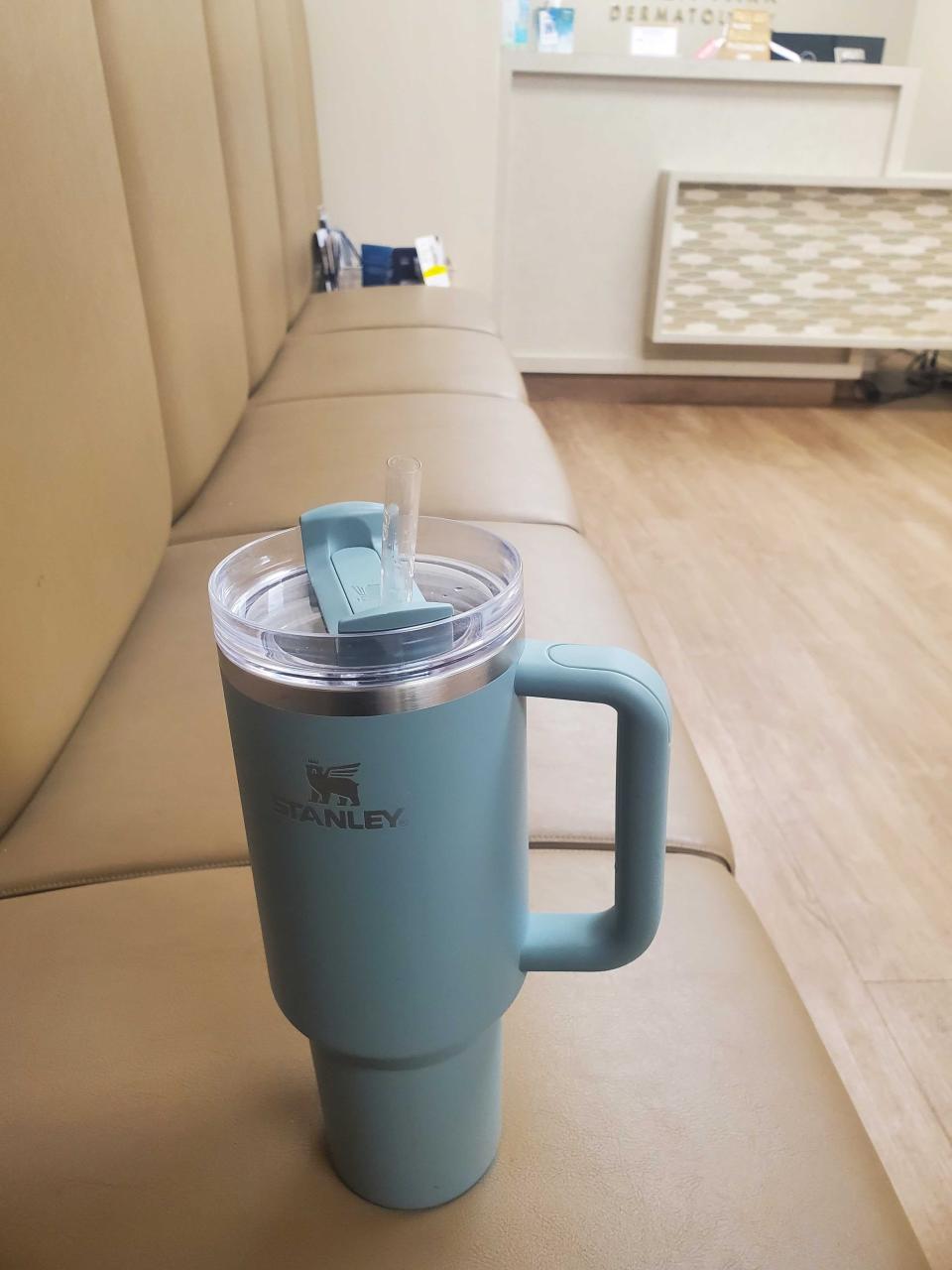
But I didn’t have too much time to contemplate all of that because I’ve signed up to take a yoga class with a friend today, so off me and Stanley go to my local studio. On this day, New York happens to be at the very beginning of a cold snap, and it is frigid outside. The Stanley, which I’ve filled with water, would have been heavy and awkward to carry even if I didn’t have a yoga mat under my other arm, but I do, and combined with the cold it is a truly miserable walk. Once I arrive at my destination, I set up my mat with my cup standing a few feet behind it. My friend sets up nearby and clocks the cup almost immediately: “Is that a Stanley?”
I know I’ll be able to explain to her after class that I’m writing about it, but I feel self-conscious about my other classmates. What if they think I’m basic? What if they think I assaulted someone at a Target in order to get it? (And which is worse?) Plus, during yoga there is always the hovering fear that while stepping into downward dog or plank, I’ll kick over my water bottle and make one of those horrific clangs metal vessels are known to make, but the size of the Stanley makes me worried that if I knock it over now the resulting noise will sound like two giant cymbals crashing together in a movie and earn me a lifetime ban from this studio and possibly all of Brooklyn. By the grace of some higher being, I manage to avoid this.
After class, my friend and I find somewhere to get a bite to eat. It’s one of those places with almost comically tiny cups for water on the table, as if the restaurant thinks it might be able to strong-arm you, through deprivation, into ordering a beverage that costs money. I leave the Stanley sitting on the table, and it looks bigger than ever towering over those puny cups.
It’s so cold out again that I have to change the rules. I was planning to keep my Stanley in one of my hands and obnoxiously on display everywhere I go, but I’m walking to meet friends about a mile and a half from my house, and it’s not enough for my hands to be in mittens—I will get frostbite if they’re not also in my pockets. I wish I had a holster for this thing, or could wrap it in my scarf, like a baby sling/StanleyBjörn. Instead, I throw the Stanley in my bag, which it fits inside only because my taste in bags tends toward the ludicrously capacious. Unfortunately, this means I forget about the Stanley and how my life is supposed to revolve around it until later, when I’m at a movie theater watching a very serious movie about the Holocaust. Despite the movie’s subject matter, people are eating popcorn and snacks around me, but I still feel like now is not the time to be unzipping and rustling, and if I dropped or clanged it I would definitely die of shame. Only later do I discover that the cup is leaking in my bag. I must have closed it wrong or something. Its top has three “settings,” and I don’t fully understand them.
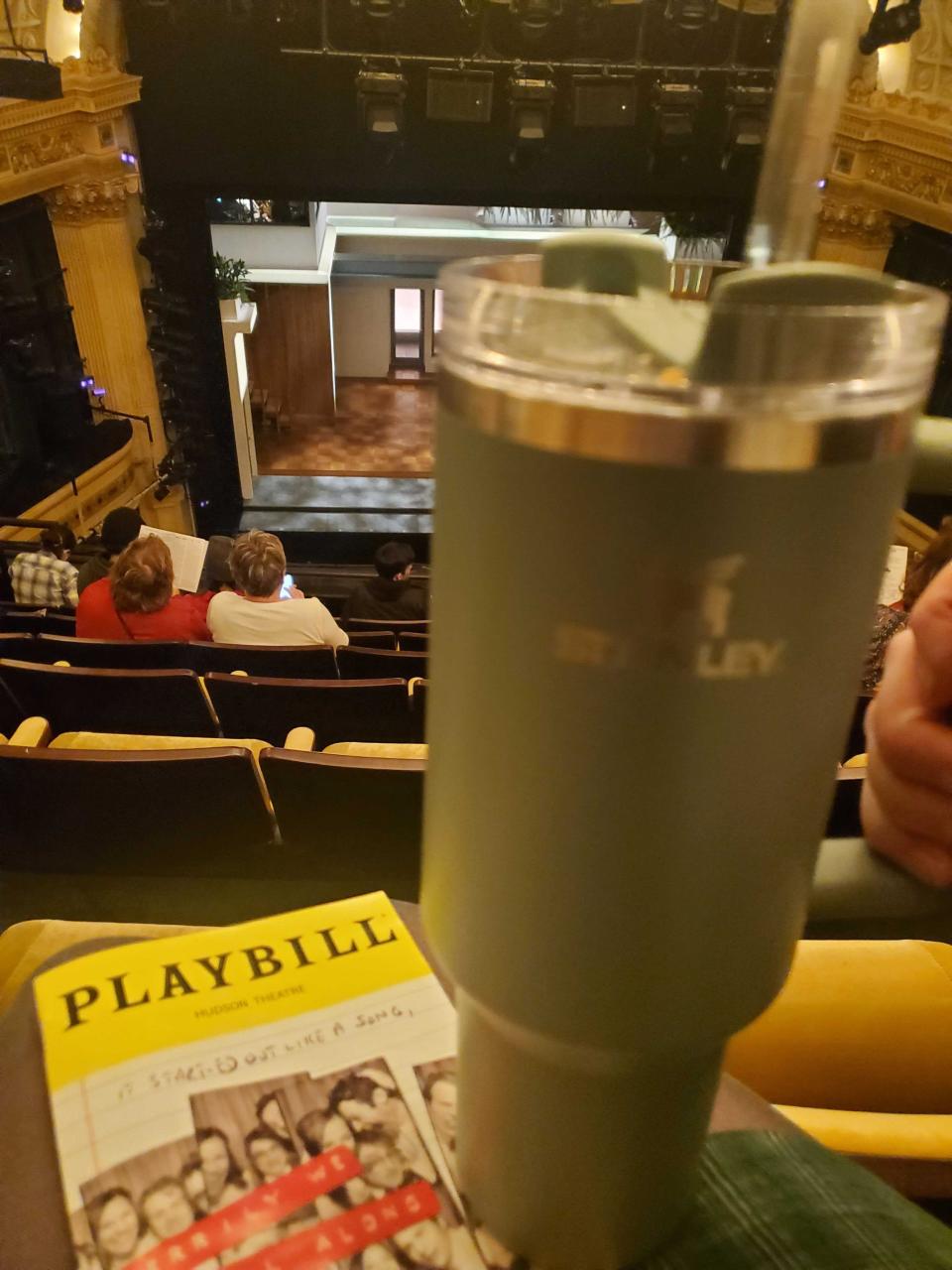
I watch an awards show that night with people and get a few more comments about the Stanley. They’re more curious than admiring. No one has revealed themselves to be a fellow cultist, yet. After almost two days of using it, I’m trying not to rush to judgment, but I’m also forming the opinion that drinking water out of a straw feels … weird. Especially yesterday at yoga or in any kind of exercise context—isn’t water better gulped or sipped directly out of the cup? It just feels inefficient to be drinking it out of a straw, fighting for drops when I have 40 freaking ounces of it.
It’s Take Your Stanley to Work Day! Even though I’ve been carrying my Stanley around with me out in the world and at home for a little while now, I’m excited for today because I’m wondering if the office might be a more natural habitat for it. So far, I’ve felt like I kind of don’t know what to do with mine—it’s like a shy friend who’s struggling to fit in that I’m dutifully bringing with me everywhere but getting a little tired of.
To make a comparison I’m not confident in because I’m not a car person, having a Stanley feels like having an SUV—it allows you to feel superior to the mere mortals in their little low-to-the-ground, un-tricked-out cars. And I think one reason I’m having trouble figuring out what to do with mine is that the best place for a Stanley might not be at home or on the go but inside an SUV—that it fits in a cup holder is one of the original reasons it gained traction among momfluencers and product bloggers a few years ago. Critics have noted that the Stanley cup “threatens to symbolize the very kind of environmentally-harmful consumption that reusable containers are supposed to end,” as Wired put it, and its compatibility with car culture is an added irony. There’s a TikTok video that parodies the Stanley craze by depicting a woman carrying around a huge wicker basket with handles with the text “Just me & my Stanley running errands” overlaid over it. This is exactly how I feel carrying my Stanley around New York City, but it’s because these cups aren’t meant to be carried around cities. The farthest distance they’re really supposed to go is from your door to your driveway.
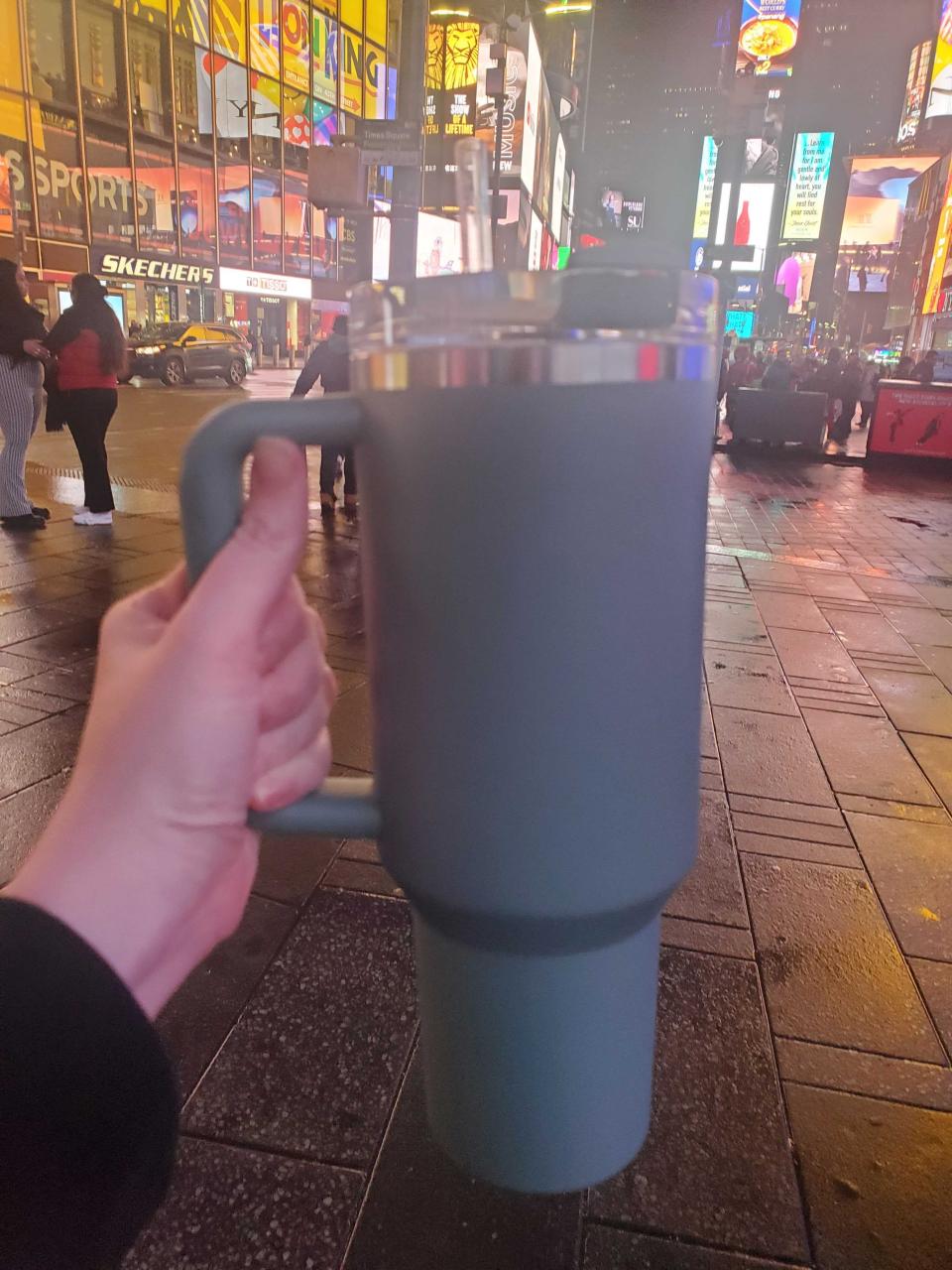
This brings us to a rather large distinction that it’s taken me a possibly embarrassing amount of time to understand: the difference between cups and bottles. All the while I was reading about Stanleys, I was thinking about the terms mostly interchangeably. I was considering this whole thing just another water bottle craze, like Hydro Flasks and VSCO girls a few years ago. But a Stanley isn’t a bottle. It’s a cup. A water bottle is portable, the kind of thing you walk around a city with and bring to the gym with you. A cup or a tumbler is something different. Maybe this is screamingly obvious to everyone, but I’m spelling it out because it wasn’t to me. And while I understand the place of a water bottle in my life, it’s becoming clear to me that I kind of don’t understand the place of a tumbler. I just don’t feel strongly about cups!
That’s why I think that as a carless person, I might find the office to be the next best thing. A tumbler can keep a drink cold for several hours while I sit in the same place and stare at a computer, so maybe I’ll like having a Stanley next to me here at work. I give it a try, but I’m having trouble seeing the appeal. When it’s sitting on my desk, the straw is too tall for my mouth to reach easily without me having to crane my neck—because this thing is too big! I also don’t think it’s keeping my water particularly cold. I put ice in and it melted. Is that viral video where a Stanley survives a car fire with ice intact a big lie?
Today I’m going to try drinking soda out of my Stanley. My attempts to get “into water” were going nowhere—I like water fine, and I should probably drink more of it. But I love Diet Coke without any accompanying sense of obligation. I definitely don’t need 40 ounces of it, but there have been many times when I’ve been drinking a Diet Coke at my desk at work and wished that it was still cold, so if the Stanley can do that for me, that would be nice. Of course, then my brain flashes to the last time I went to the dentist, which is on my mind because I’m going back in a few days. They tsk-tsked my soda habit, but it surprised me when they specifically asked me if I was sipping soda. How else would a person drink it? But evidently the problem is not so much that I drink soda at all, but that I sip it over too long a period of time. How college: I was being accused of babysitting drinks! Excuse me for wanting to make an experience last! Apparently I would be better off shotgunning the soda so it didn’t stay on my teeth as long and my mouth’s pH balance could be restored … boop, end of dental flashback. Isn’t it funny that the one thing the Stanley might be able to legitimately help me with is an activity I’ve been explicitly warned to avoid?
Against medical advice, I pour a can of Diet Coke into the Stanley. It gives me a similar uncanny feeling to drinking water out of the straw. I think I’ve been Pavlovianly trained to enjoy drinking Diet Coke out of the can at my desk, and my brain is having trouble processing it coming out of another vessel.
Later, I visit a 7-Eleven, where I debate the etiquette of buying a cup of soda and then pouring it into my Stanley vs. just directly filling the Stanley at the fountain. I decide to be sustainable and not waste the cup. I fill up and go to the counter. The clerk looks slightly confused when I ask to pay for a Big Gulp without appearing to be holding a Big Gulp, but I hold up my Stanley and say it’s in there, and he seems to get it, though something tells me this is not yet a common occurrence. But conversion is tricky. I had assumed the biggest Big Gulp had to be bigger than my Stanley, but the sizes weren’t labeled well and I might have actually stolen 8 ounces of soda from the store. I carry my big soda around the city and sip it and it’s nice, probably the most pleasant experience I’ve had with the Stanley.
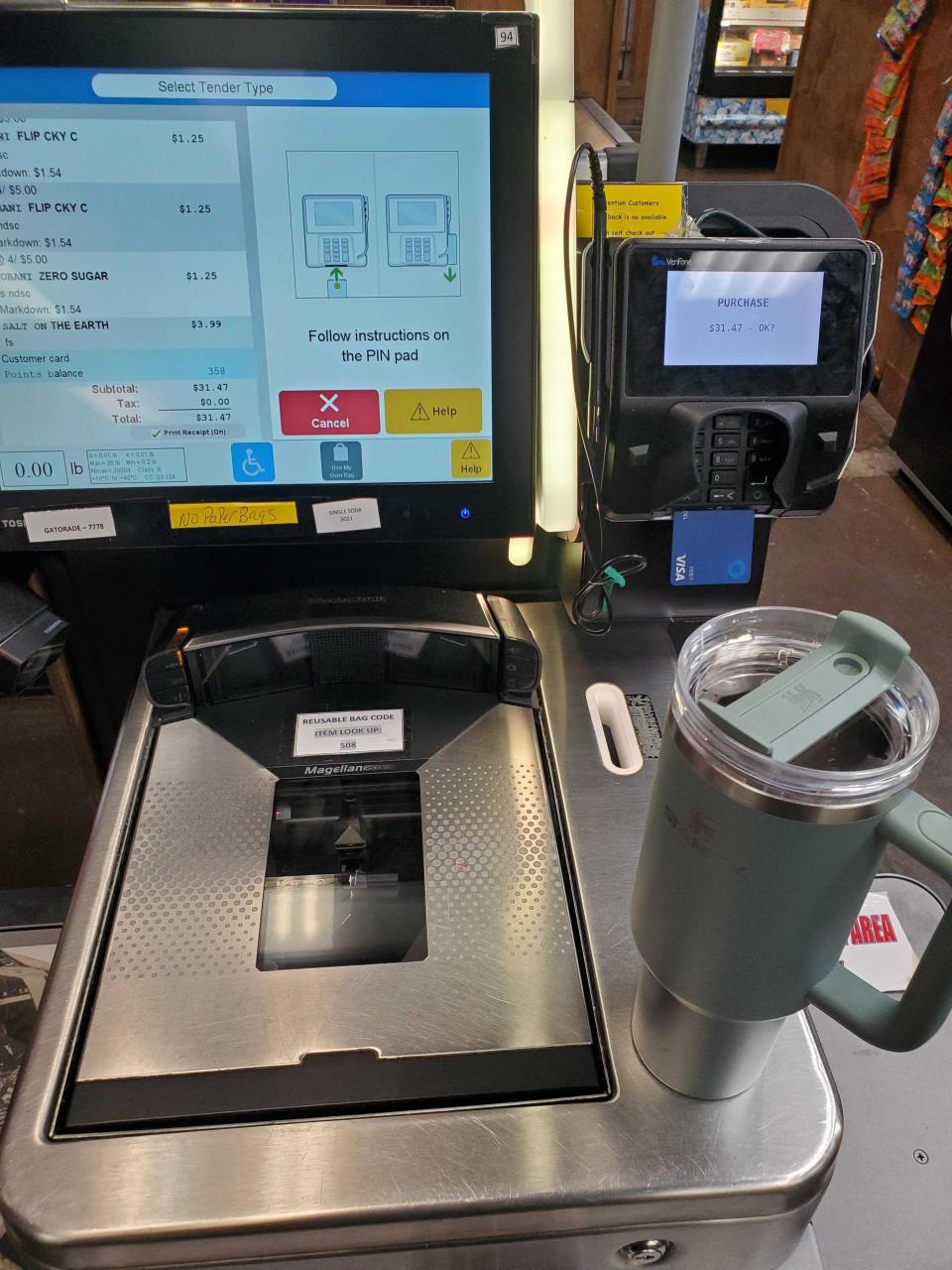
While walking, my friend tells me I should be holding the Stanley like a beer stein, with my hand through the handle but wrapped around the cup, rather than like a mug, with my hand only on the handle and not touching the cup at all, because it will distribute the weight better. It’s true, this is much more comfortable, and I probably looked like an idiot before. Once again, the depths of what I didn’t know about cups astound me.
All week, I have expected more people to comment on the Stanley, to maybe be going around with their own Stanleys and to clink them with mine in hydration solidarity, but no one has really cared, even when I’ve tried to ostentatiously wield it in someone’s line of vision. At a vintage store where they make you check your bags before browsing, I held it up to the woman behind the counter. “Do I need to check this?” I asked hopefully—it was definitely large enough to stuff at least a few pairs of underwear in. But she let me keep it.
Cleaning reusable water vessels is kind of impossible, but I’ve done it and I’m ready to fill the Stanley with water again. Because I know it leaks, if I have to put it in a bag to take it anywhere, I’ve been emptying it out first, which is really inconvenient, so today I’m determined to figure out whether there’s something to do to make the leaking stop. I’ve been drinking it mostly out of the straw, but maybe one of the other settings? But then I do the tiniest amount of research and discover that you can’t stop Stanley cups from leaking—they are just known to leak. It’s been written about lots of places—the New York Times’ Wirecutter doesn’t recommend Stanleys specifically because of the leaking. I’m both baffled and incensed by this. I know: Everyone else is putting the cup in their cup holder, so it doesn’t matter if it leaks a little when sideways, but the whole job of a cup is not to leak! May I remind you that this thing costs $45!
I decide to also look into my issue of it not keeping my beverages cold or my ice frozen. I Googled “stanley cup not keeping ice” and clicked on a link that promised “6 Reasons Your Stanley Cup Won’t Keep Drinks Hot or Cold Anymore”: “When your Stanley cup stops working and won’t keep drinks hot or cold anymore, it’s usually because the vacuum-insulation has been compromised, allowing conductive heat to transfer into and out of your bottle with little resistance,” I read, imagining the aide from that George W. Bush meme whispering into the president’s ear, “The Stanley has been compromised.” But my Stanley is new and uncompromised.
Another possible explanation is that I’m not putting enough ice in it: “A few cubes in your giant Stanley isn’t going to do all that much. … To maximize ice retention, fill your cup at least ½ full of ice. And if you’re only drinking water and melted ice watering down your drink isn’t a concern, aim for somewhere closer to ¾ full.” Well, that’s pretty bossy! I thought it was up to me how much ice I wanted to put in my drink. But I suspect that the real problem is reason No. 5 on that list, that I’m not sealing the lid tightly enough. And the reason I haven’t been closing the lid very tightly is that I’m notoriously weak and I know that the more tightly I close it, the harder it’s going to be for the next guy (me) to open it. The lid is plastic, so it’s impossible to get any grip on it, and half the time you accidentally rotate the “quencher” tab when you’re trying to close or open it. So, we have learned: The Stanley is a leaky water cup (not bottle) with an impossible-to-open lid and a temperamental attitude about whether it will consent to store a beverage at your desired temperature, and I’m getting tired of its bullshit.
I’m done trying to use the Stanley like a normal person. Today I want to try an experiment. I’ve been thinking back to elementary school—remember Thermoses? A thermos is a generic term, but it’s also a proper noun and a brand: Thermos. They strike me as the most tragic figures of our chic reusable liquid vessel moment: They were decades ahead of the curve, but they couldn’t manage to capitalize on their name recognition in order to become a S’well or a Hydro Flask or a Stanley. They’re like Betamax or Skype—corporate cautionary tales.
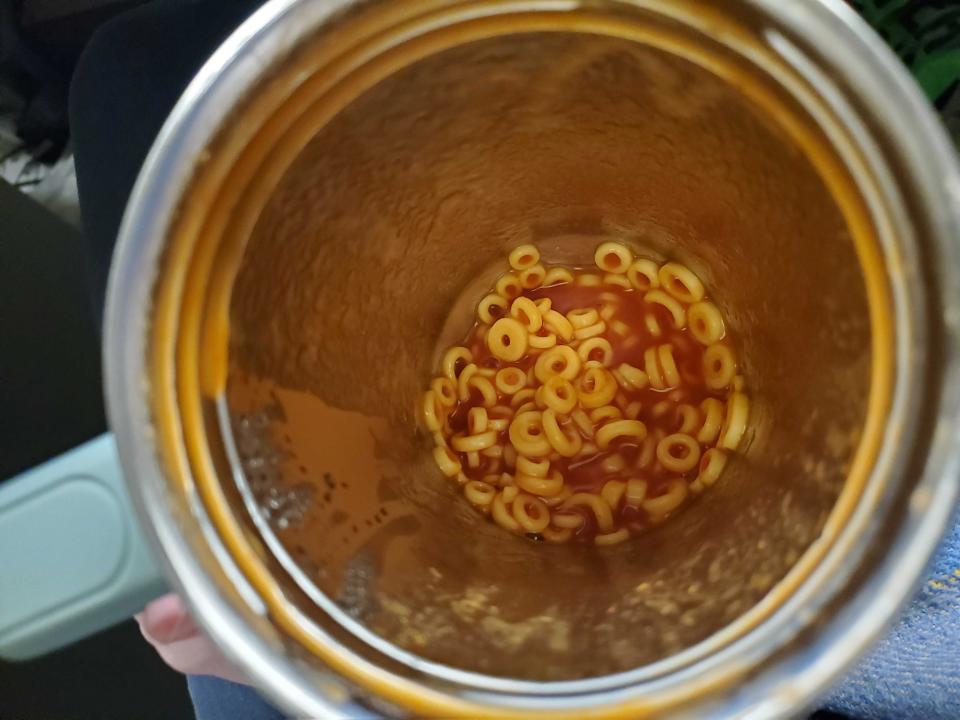
Anyway, in elementary school, kids would sometimes bring SpaghettiOs to school in thermoses, so I decide to try putting SpaghettiOs in my Stanley. I make a can at home in a bowl and dump them in. I try to close the lid as tight as I possibly can, but it still leaks a big old red-orange stain onto my tote bag. I knew it would; I am transporting these SpaghettiOs in a Stanley out of spite at this point. The SpaghettiOs sit on my desk for several hours before I endeavor to open them—I say “endeavor” because the lid is so hard to open after I closed it so tightly that I want to cry. What a piece of shit! I did this to myself, but still! Trying to eat them (hey, I don’t want to waste food) is a frustrating, messy disaster, and to add insult to injury, the Stanley kept them warm but not hot. But it was snowing on and off while all this was going on, which gave me an idea for the next day.
I had definitively proved that the Stanley sucked at storing something it was never designed to store, and now I was going to prove that it couldn’t do something I wasn’t sure it was even possible to do at all: I was going to try to save some snow in it. After midnight, I located some untrammeled snow from atop a piece of outdoor furniture in a backyard I had access to. It had hardened a little, so it wasn’t powdery, but it was still unmistakably snow. I know snow is dirty and this is arguably gross—Reese Witherspoon got yelled at online around the same time I was doing this, for making a recipe using snow that was sitting on top of her grill. But I wasn’t going to eat or drink this snow. I was just going to observe it.
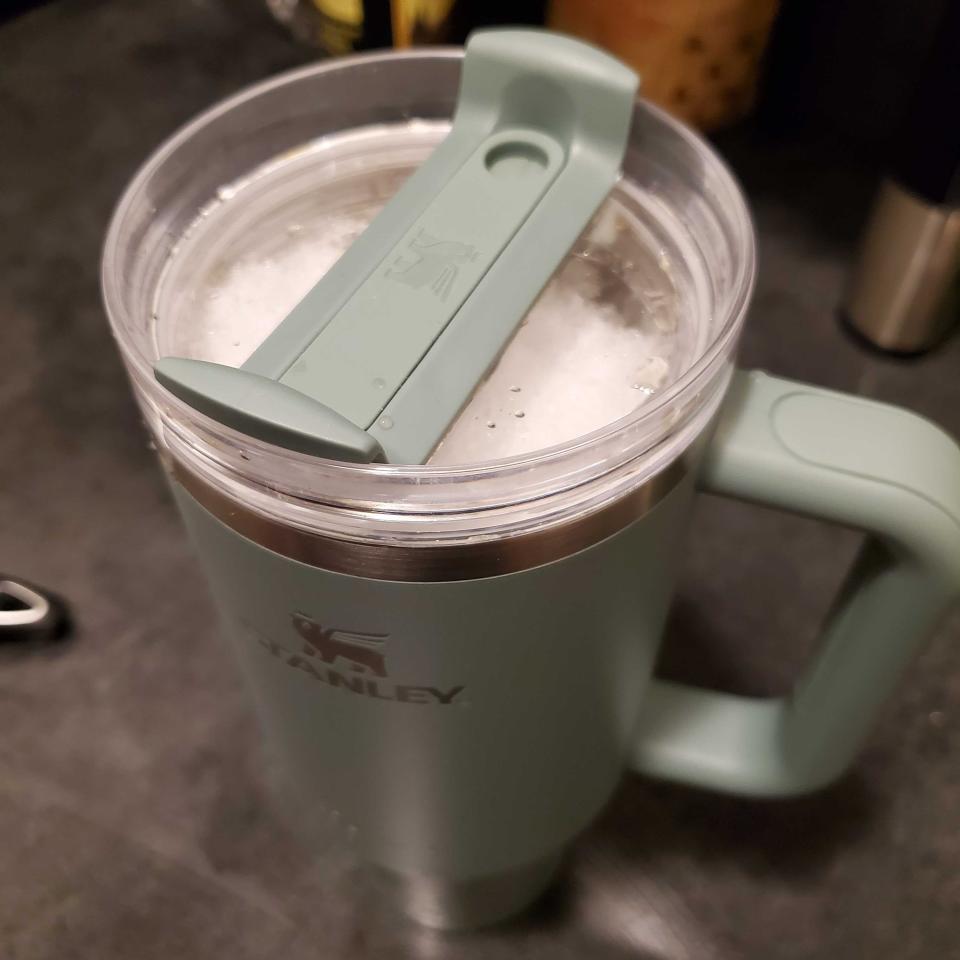
I left the Stanley full of snow on the kitchen counter and checked on it the next morning. The snow had shrunk—the cup had looked full when I’d left it, and now it was more like two-thirds or three-fourths full, and it looked more like ice than snow. I had a busy day planned, so I stuck it in a tote bag and brought it along everywhere: first to the dentist (suspiciously, they said nothing about my soda drinking), then brunch. In the afternoon, the “snow” still seemed solid, if condensed. I went to a museum next and checked it with my coat—should I have carried a Stanley full of snow around the galleries, to achieve never-seen-before levels of manic pixie dream girl?—and by the time I left, the “snow” was finally more liquid than solid. It was in fact now leaking in the plastic bag it was in, and it was time to be rid of it. All told, it was still cold and not entirely liquid 16 or so hours after being captured, whatever that tells us about this tumbler’s magic capabilities. So, yes, that was me dumping a Stanley full of melted snow out in front of the Whitney last weekend.
My verdict: I don’t really care for it as a container for liquid, but I believe in the Stanley as a vessel for performance art.

